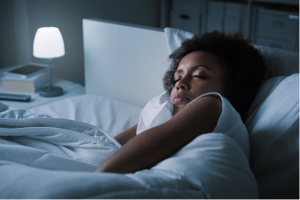Can the Way You Sleep Determine Progression of Neurological Disorders?
Sleep is a mystery that everyone encounters daily. Many generations have tried to understand its purpose and relation to behavioral health. Dreams drew the attention first, prompting interpretation of their symbolic contents based on a spectrum of theories from esoterism to psychoanalysis. In 1953, Nathaniel Kleitman and Eugene Aserinsky described periods of rapid eye movement (REM) associated with dreaming and started the scientific study of sleep. Periodicity implied a complex sleep structure with two major components: REM sleep and non-REM sleep. Later studies found that many sleep-associated disorders such as sleep paralysis and night terrors occurred with either REM or non-REM sleep, but not both.

Image credit: Terry Cralle, RN
David Kupfer and Gordon Foster studied sleep in 35 patients with major depression and found that their patients had an earlier onset of REM sleep. Moreover, the latency of REM sleep (the interval between falling asleep and the start of REM sleep) correlated with the severity of depression. In 1972, they reported the average REM latency of 35 minutes among 35 depressed patients, and 18 minutes in those with severe depression. The normal values should exceed 50 minutes. Finding a biological marker of depression enthused psychiatrists who traditionally relied on subjective diagnostic criteria. Sleep studies quickly became common in the psychiatric centers. By 1992, R. M. Benca and coauthors selected 177 studies of sleep in several mental disorders and pooled the sleep data from 7151 patients and controls. A shortened REM latency occurred in schizophrenia, though more frequently in schizoaffective disorder. The sleep parameter with the highest specificity for major depression was the frequency and intensity of rapid eye movements during REM sleep referred to as REM density. By 2011, Vivek Pillai, David Kalmbach and Jeffrey Ciesla were able to pool 56 studies focusing on sleep in major depression into a meta-analysis. An increased REM density and shorter duration of slow-wave non-REM sleep (SWS) were 2 measures that persisted after resolution of depression and were found in never-depressed close relatives of patients with major depression. Therefore, these 2 sleep parameters may serve as objective tests for genetic biomarkers of major depression regardless of current symptoms.
The search for brain disorders associated with abnormal sleep was less successful in other disorders. In 1963, long before overnight sleep studies became routine, Donald Bennet described major motor convulsions in 4 healthy sleep-deprived men. Further, research zeroed in on the effects of sleep on seizure rather than the opposite.
Recurrent seizures and increased electrical activity within the brain define epilepsy. Michele Sammaritano and co-authors studied localization of electrical epileptic focus within the temporal lobe using an electroencephalogram and recorded the activity of multiple areas of the brain during sleep and wakefulness. In 1991, they reported suppression of electrical epileptic foci in REM sleep. Ten years later, in 2001, S. T. Herman and coauthors detected no seizures during REM sleep and observed that most seizures occurred in the frontal lobe during non-REM sleep.
It is difficult to diagnose epilepsy unless seizures are witnessed. The patients usually do not remember a seizure during sleep. Finding a biological marker of epilepsy that is detectable between seizures would be a game changer in the clinical practice. Researchers tried to identify seizure-induced sleep changes, but it was not until 2000 when Carl Basil and coauthors reported a reduction in REM sleep within several hours after a seizure originated in the temporal lobe. Night seizures produced a much stronger affect than seizures during the preceding day.
Interestingly, sleep changes are opposite in epilepsy and major depression. If temporal seizures suppress REM sleep, that in its turn, inhibits seizure activity. This type of epilepsy should be relentlessly progressive and frequently observed. Repetitive shortening of REM sleep with multiple seizures may produce detectable long-term changes in sleep, serving as a biological marker of temporal lobe epilepsy. As is the case with major depression, some sleep parameters may be better than others, and the search for an accurate and reliable marker is still ongoing. However, the association between sleep and neurological disorders has certainly intrigued researchers to continue to delve deeper into how these orders intertwine, so perhaps answering the question of whether sleep structure can predict progression of neurological disorders can definitively be answered.
This blog post was submitted by Anastasia Tyulmenkova as part of our Summer 2020 blog contest. You can vote for your favorite on our Twitter, Facebook and LinkedIn. The winner will be announced on September 14, 2020.
References
- Aserinsky, E., & Kleitman, N. (2003). Regularly occurring periods of eye motility, and concomitant phenomena, during sleep. 1953. The Journal of Neuropsychiatry and Clinical Neurosciences, 15(4), 454–455.
- Bazil, C. W., Castro, L. H., & Walczak, T. S. (2000). Reduction of rapid eye movement sleep by diurnal and nocturnal seizures in temporal lobe epilepsy. Archives of Neurology, 57(3), 363–368.
- Bennett, D. R. (1963). SLEEP DEPRIVATION AND MAJOR MOTOR CONVULSIONS. Neurology, 13, 953–958.
- Benca, R. M. (1992). Sleep and Psychiatric Disorders. In Archives of General Psychiatry (Vol. 49, Issue 8, p. 651). https://doi.org/10.1001/archpsyc.1992.01820080059010
- Herman, S. T., Walczak, T. S., & Bazil, C. W. (2001). Distribution of partial seizures during the sleep–wake cycle: differences by seizure onset site. Neurology, 56(11), 1453–1459.
- Kupfer, D. J., & Foster, F. G. (1972). Interval between onset of sleep and rapid-eye-movement sleep as an indicator of depression. The Lancet, 2(7779), 684–686.
- Pillai, V., Kalmbach, D. A., & Ciesla, J. A. (2011). A meta-analysis of electroencephalographic sleep in depression: evidence for genetic biomarkers. Biological Psychiatry, 70(10), 912–919.
- Sammaritano, M., Gigli, G. L., & Gotman, J. (1991). Interictal spiking during wakefulness and sleep and the localization of foci in temporal lobe epilepsy. Neurology, 41(2 ( Pt 1)), 290–297.


